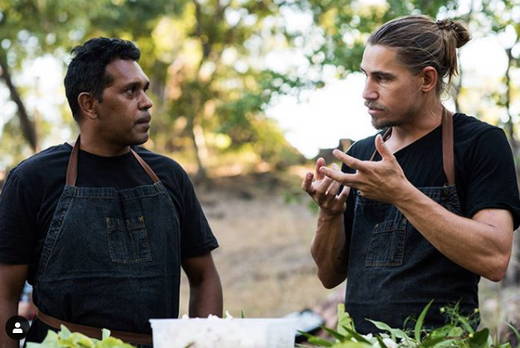eat like an aussie (and we're not talking about lamingtons)
by team nuut

Native-food evangelist Paul Iskov from Fervor in Perth is one such chef. He established his business with the aim of providing a “culinary experience you can’t get anywhere else”. Harnessing locally sourced native produce and sharing it with diners at unique locations across Western Australian, his pop-up restaurants can be found by salt lakes, in beautiful bush land, and on pristine beaches.
“One day we are in the Pinnacles Desert, the next on a remote island off the Southern Coast of Western Australia,” says Paul. “Every event is an adventure to learn and reflect upon in this diverse and beautiful country.”

image via @fervorfood
For Paul, key focus is connecting with traditional owners and high-quality native ingredients. He experiments with exotic plants, from silky pear, bush banana and native thyme to warrigal greens and lemon myrtle. Each ingredient is all-seasonal, naturally high in protein, low glycaemic, low salt, sustainable, and most importantly, absolutely delicious.
“It’s easy to make nutritious food when the ingredients you are using have integrity,” agrees Paul. “Kakadu plum has the highest vitamin C content of any food in the world. Wattle seed and pepper berry are blowing superfoods out of the water, and bush banana and honey ant are really good for you. We are so lucky to have these healthy ingredients on hand that also taste delicious.”
“It’s easy to make nutritious food when the ingredients you are using have integrity".
Paul also loves to forage for coastal-grown herbs and vegetation. “I use a lot of saltbush, samphire, dune spinach, and sea celery which has an incredible flavour,” he says. “When it comes to experimenting with native plants, it’s important to keep an open mind and enjoy the experience. I find people walk away pleasantly surprised.”
Intrigued? Read up on some of Paul’s favourite native ingredients below, and whip up Macadamia, a recipe from his cookbook Fervor: A Journey Through Australian Native Food.

image via @fervorfood
Ingredients
Youlk
Also known as Ravensthorpe radish, youlk is one of many edible bushfood roots in traditional cuisine. With its crisp apple-like texture, golden potato colour and hints of carrot and sweet eucalypt flavour, it is a tasty ingredient for salads, stews, pies, gratin, and cakes, or simply roasted, baked or fried with a little butter and salt. “It’s so versatile,” agrees Paul. “Eat raw or throw on the barbie. We also like to pickle and ferment it.”
Finger Limes
Referred to as citrus caviar for its hundreds of teardrop-shape translucent sacks, the diminutive fruit’s bright, sweet-tart flavour has helped it go from barely known curiosity to mainstream ingredient.
Waterlilies
In Kakadu, people eat the stems, root and the flower head of the waterlily. The stems are peeled back for eating and taste a bit like celery. Find the seeds inside the old flower seed heads and crunch them up for a creamy taste.
Boab Tuber
Baby boab roots are the tap root of the tree when it’s just a seedling. The roots grow like a carrot, and the texture of the tuber is similar to water chestnuts. They are crisp and white with a sweet delicate flavour. Serve raw, or lightly cooked, and use in salads, stir-fry and soups, or julienne for dips. Boab leaves are also edible and have a nutty flavour perfect for salads, soups and stir-fries, or as a garnish.
Warrigal Greens
Often referred to as native spinach, this nutrient-dense, antioxidant-rich succulent grows like a weed in coastal parts of the country. Unlike English spinach, cooked warrigal greens retain their flavour, form, and chlorophyllic punch.
Lemon Myrtle
The creamy blossoms of this bush plant exude an invigorating perfume that whiffs of honey, citrus, and eucalyptus. When used sparingly, its powerful flavour provides a delicate note to dishes. “We find ours down south near Albany,” Paul says. “It has an aroma and taste that is incredible. It’s easy to use at home in a curry, salad or in a dressing.”
recipe

image via @micksippeimage for Fervor